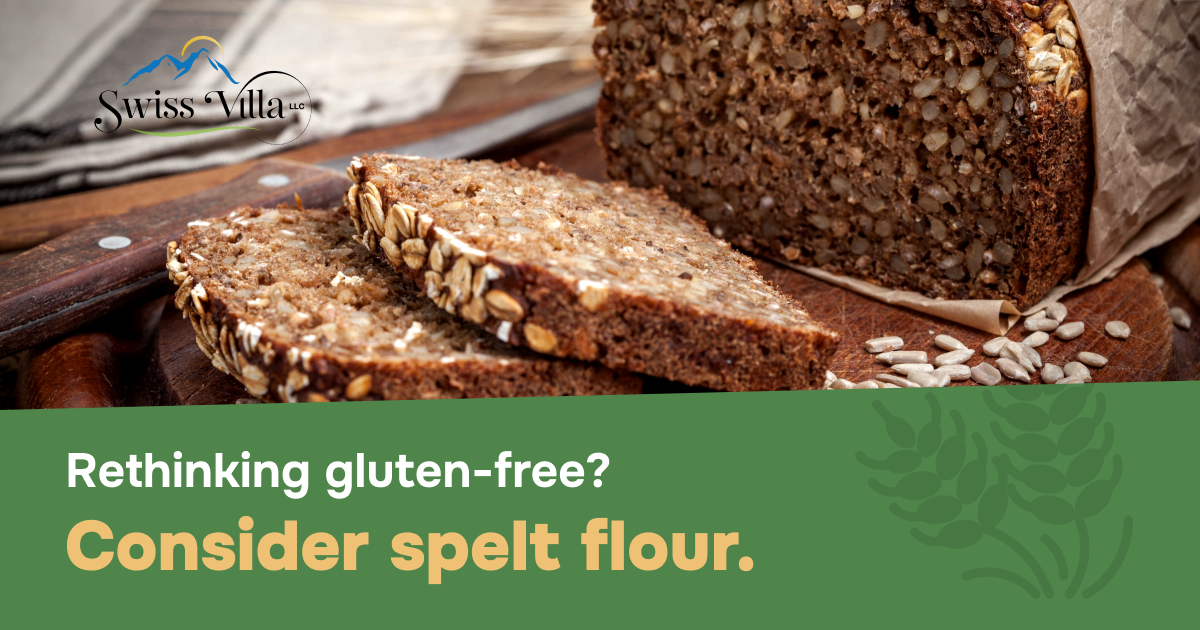
Spelt — Gluten Free? Why Spelt Crumbs for Me?
We hear so much discussion about going on a gluten free diet. Why has gluten become such an issue? What about the ancient grains consumed by our great-grandparents in yesteryears? Could GMO grains be a factor in our digestion struggles or celiac disease? If so, what does spelt flour hold for gluten sensitivity? And what values of prebiotics do we find in spelt?
Spelt, an ancient grain
Spelt is an old-world grain with a fragile gluten. That means it has not been developed like the modern-day wheat has been. Yet it is a distant relative of the common wheat in America today. But the gluten in spelt breaks down much easier, whether in baking or in our digestive systems. Thus there is a significant difference between the two.
We have been eating refined foods too long with finery. And our bread must stick together without any crumbs. Bread crumbs are for the poor and we are not there! And so, the bakers needed more of a binding gluten in their breads for less crumbs. The seed companies listened and tailored the hybrid grains into a stronger, binding gluten.
And they succeeded. But the pain is now ours. Irritable Bowel Syndrome, IBS and many other problems we deal with today may simply have connections to the over-binding gluten of the modern-day wheat.
Must we all be gluten free in order to live comfortably? Or do the natural, old-world grains with easier to digest gluten that have not been GMO changed offer health to us? Let’s consider a few health benefits of spelt flour.
Now quoting from Jamie Ashcraft at HiStakes Spelt:
Spelt’s uniqueness is derived from its genetic makeup and nutrition profile. Spelt has high water solubility, so nutrients are easily absorbed by the body making it easy to digest. It is high in protein (significantly higher than wheat), higher in B complex vitamins, and spelt is high in both simple and complex carbohydrates. These complex carbohydrates are an important factor in blood clotting and stimulating the body’s immune system. Spelt is a suberb fiber resource.
Spelt flour, contains a fragile gluten
Also called “farro” or “dinkel”, spelt does have some gluten. It is not a gluten free diet food. Other similar old world grains such as Kamut, triticale, emmer and einkorn also contain gluten and are wheat relatives. Celiac patients cannot tolerate these grains. However, folks with gluten sensitivity may be able to comfortably consume and digest spelt and other old world grains. Remember, every person’s body may respond differently.
Spelt, holds rich minerals and vitamins
Why take capsules of manufactured nutrients when we can eat them naturally? And so, source your iron, magnesium, calcium and phosphorus from natural spelt flour bakery items. Calcium and phosphorus bind together into crystals to make up bones and teeth. Eat calcium and phosphorus rich spelt items for bone and teeth health. Phosphorus also helps maintain proper pH levels.
Spelt sports the complex B vitamin Thiamin which helps the body change carbohydrates into energy, muscle contraction and nerve signals. And then too, the complex B vitamin Niacin which gives good adrenal health comes along in the package of spelt nutrients.
Spelt is a good source for zinc, copper and iron. The iron along with the copper in spelt aids in red blood cell count and thus, increases blood circulation. And increased blood flow helps lower blood pressure. And consequently better blood flow gives better overall health to many aspects of our bodies.
Spelt, high in fibrous prebiotics
A good fiber such as found in spelt can help to eliminate bad cholesterol. Spelt has one of the highest fiber contents of all the wheat family. And the good amount of resistant starch in spelt provides a rich source prebiotic matter. Prebiotics aid the internal growth of probiotics from foods such as yogurts, kefir, kvass, raw sauerkraut and kimchi, and kombucha.
High fiber foods promote regularity. This in turn, aids in detoxification and a healthier body.
Diabetics may benefit from the fiber in spelt flour. And additionally, some say the GI of spelt is lower than wheat. You may want to consider spelt bread for a type 2 eating plan.
Spelt, rich in fatty acids
Spelt holds about 12% protein. And spelt protein contains the full spectrum of all essential fatty acids. Spelt, rich in silicate, may have a positive effect on concentration and mental power and also on the health of your skin and hair.
Sylvia’s Spelt Bread
A few years ago, Sylvia started baking spelt flour bread and other bakery goods with spelt flour. Her little summer kitchen buzzed with flurry weekly in preparing bread for natural food stores to sell on their shelf. and many folks have become faithful customers of this spelt bakery line.
Then a couple years ago Sylvia sold her little bakery business to neighboring friends who continue baking with this flour from GMO free spelt grains. They too have a small bakery in their summer kitchen close by the farm house in which they live. This young family wants to provide healthy baked goods to you and your s as they continue baking on a small scale to assist in providing for their family’s income.
Swiss Villa endeavors to serve small farms and businesses by helping to market and carry these goods to the marketplaces for them. We thank you for considering this bread for your daily table. It helps another family to “put bread on their table” as well. Thanks again.
Want to give it A try?
Try our Cinnamon Raisin Spelt Bread Below


